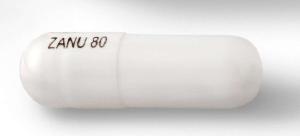Zanubrutinib and Alcohol/Food Interactions
There are 2 alcohol/food/lifestyle interactions with zanubrutinib.
Zanubrutinib Food/Lifestyle
Major Food Interaction
GENERALLY AVOID: Grapefruit and/or grapefruit juice may increase the plasma concentrations of zanubrutinib. The proposed mechanism is inhibition of CYP450 3A4-mediated first-pass metabolism in the gut wall by certain compounds present in grapefruit. Inhibition of hepatic CYP450 3A4 may also contribute. The interaction has not been studied with grapefruit juice, but has been reported for other CYP450 3A4 inhibitors. When zanubrutinib was coadministered with the potent CYP450 3A4 inhibitor itraconazole (200 mg once daily), zanubrutinib peak plasma concentration (Cmax) and systemic exposure (AUC) increased 157% and 278%, respectively, in healthy volunteers. Data evaluating coadministration of zanubrutinib, in patients with B-cell lymphoma, and several other known CYP450 3A4 inhibitors have been reported. When zanubrutinib was coadministered with another CYP450 3A4 inhibitor, clarithromycin (250 mg twice daily), zanubrutinib Cmax and AUC increased 101% and 92%, respectively. The moderate CYP450 3A4 inhibitor diltiazem (180 mg once daily) increased both zanubrutinib Cmax and AUC increased by 62%. Another moderate CYP450 3A4 inhibitor, fluconazole (400 mg once daily), increased zanubrutinib Cmax and AUC 81% and 88%, respectively. Clinical data for less potent inhibitors are not available. In general, the effects of grapefruit products are concentration-, dose- and preparation-dependent, and can vary widely among brands. Certain preparations of grapefruit (e.g., high dose, double strength) have sometimes demonstrated potent inhibition of CYP450 3A4, while other preparations (e.g., low dose, single strength) have typically demonstrated moderate inhibition. Increased zanubrutinib exposure may potentiate the risk of toxicities such as hemorrhage, infection, cytopenias, malignancies, and serious cardiac arrhythmias, primarily atrial fibrillation and atrial flutter.
Food does not affect the oral bioavailability of zanubrutinib. No clinically significant differences in zanubrutinib Cmax or AUC were observed following administration of a high-fat meal (approximately 1000 calories; 50% from fat) in healthy subjects.
MANAGEMENT: Zanubrutinib may be administered with or without food. Patients should avoid consumption of grapefruit, grapefruit juice, Seville oranges (a citrus relative of the grapefruit), and Seville orange juice during treatment with zanubrutinib. Close clinical monitoring for development of zanubrutinib-related toxicities, dosage adjustments, and/or withholding treatment in accordance with product labeling is advised. Additional consultation with individual package labeling, as well as relevant institutional protocols, may be advisable for further guidance.
References (3)
- (2025) "Product Information. Brukinsa (zanubrutinib)." BeiGene USA, Inc
- (2024) "Product Information. Brukinsa (zanubrutinib)." Beigene Aus Pty Ltd
- beigene switzerland gmbh (2025) Zanubrutinib PRODUCT MONOGRAPH https://pdf.hres.ca/dpd_pm/00078143.PDF
Switch to consumer interaction data
Zanubrutinib High Blood Pressure (Hypertension)
Moderate Potential Hazard, Moderate plausibility
zanubrutinib - arrhythmias
Serious cardiac arrhythmias have been reported with zanubrutinib. Atrial fibrillation and atrial flutter have occurred in patients treated with zanubrutinib monotherapy. Care should be exercised when using this agent in patients with cardiac risk factors, hypertension, and acute infections as they may be at increased risk of cardiac arrhythmias. It is recommended to monitor for signs/symptoms of cardiac arrhythmias, manage appropriately, and consider the risks and benefits of continued treatment with zanubrutinib.
References (1)
- (2023) "Product Information. Brukinsa (zanubrutinib)." BeiGene USA, Inc, SUPPL-10
Switch to consumer interaction data
Zanubrutinib drug interactions
There are 531 drug interactions with zanubrutinib.
Zanubrutinib disease interactions
There are 6 disease interactions with zanubrutinib which include:
More about zanubrutinib
- zanubrutinib consumer information
- Check interactions
- Compare alternatives
- Reviews (65)
- Side effects
- Dosage information
- During pregnancy
- Drug class: BTK inhibitors
- Breastfeeding
- En español
Related treatment guides
Drug Interaction Classification
| Highly clinically significant. Avoid combinations; the risk of the interaction outweighs the benefit. | |
| Moderately clinically significant. Usually avoid combinations; use it only under special circumstances. | |
| Minimally clinically significant. Minimize risk; assess risk and consider an alternative drug, take steps to circumvent the interaction risk and/or institute a monitoring plan. | |
| No interaction information available. |
See also:
Further information
Always consult your healthcare provider to ensure the information displayed on this page applies to your personal circumstances.


